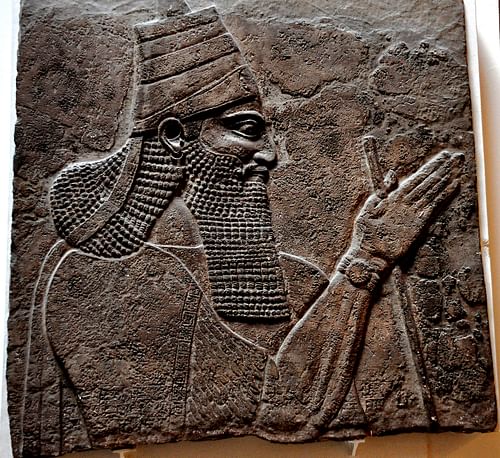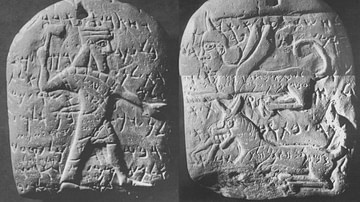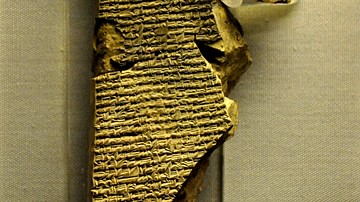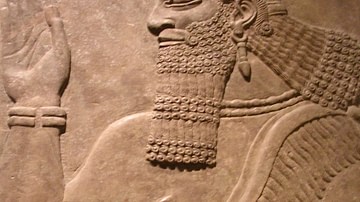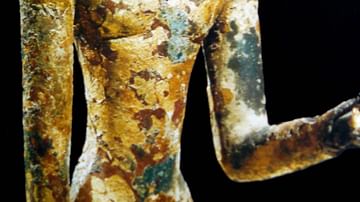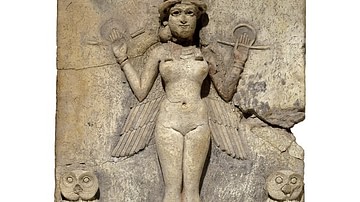
Assur (also Ashur, Anshar) is the god of the Assyrians who was elevated from a local deity of the city of Ashur to the supreme god of the Assyrian pantheon. His attributes were drawn from earlier Sumerian and Babylonian deities and so he was, at once, a god of war, wisdom, justice, agriculture, and kingship among others.
The Assyrian Empire, like the later Roman Empire, had a great talent for borrowing from other cultures. This penchant is illustrated clearly in the figure of Assur whose character and attributes draw on the Sumerian and Babylonian gods. Assur's family and history are modeled on the Sumerian Anu and Enlil and the Babylonian Marduk; his power and attributes mirror Anu's, Enlil's, and Marduk's as do details of his family: Assur's wife is Ninlil (Enlil's wife) and his son is Nabu (Marduk's son). Assur had no actual history of his own, such as those created for Sumerian and Babylonian gods but borrowed from these other figures to create a supreme deity whose worship, at its height, was almost monotheistic. Scholar Jeremy Black notes:
In spite of (or possibly because of) the tendencies to transfer to him the attributes and mythology of other gods, Assur remains an indistinct deity with no clear character or tradition (or iconography) of his own. (38)
Assur had power over the kingship of Assyria but, in this, was no different from Marduk of Babylon. The king of Assyria was his chief priest and all those who tended his temple in the city of Ashur and elsewhere lesser priests. Assyrian kings frequently chose his name as an element in their own to honor him: Ashurbanipal, Ashurnasirpal I, Ashurnasirpal II, etc.
Worship of Assur consisted, as with other Mesopotamian deities, of priests tending the statue of the god in the temple and taking care of the duties of the complex surrounding it. Although people may have engaged in private rituals honoring the god or asking for assistance, there were no temple services as one would recognize them in the modern day.
The iconography of Assur is often taken from the Sumerian god An/Anu, a crown or a crown on a throne, but he is as frequently represented as a warrior-god wearing a horned helmet and carrying a bow and quiver of arrows. He wears a short skirt of feathers and is sometimes depicted within a winged disk (although the association of Assur with the solar disk is contested by a number of modern scholars, among them Jeremy Black). Assur is also sometimes represented standing on a snake-dragon, an image borrowed from the Babylonian Marduk, among other gods.
Early Origins
Assur is first positively attested to in the Ur III Period (2047-1750 BCE) of Mesopotamian history. He is identified as the patron god of the city of Ashur c. 1900 BCE at its founding and also gives his name to the Assyrians. From a local, and probably agricultural, god who personified the city, Assur steadily acquired greater and greater attributes. The scholar E. A. Wallis Budge describes the general progression gods made from spirits to local deities to supreme gods:
The oldest of such spirits was the "house spirit" or household-god. When men formed themselves into village communities the idea of the "spirit of the village" was evolved and later came the "god of the town or city" and the "god of the country". Each of the elements, earth, air, fire, and water had its spirit or "god", the earthquake, lightning, thunder, rain, storm, desert whirlwind, each likewise its spirit or "god", and of course each plant, tree, and animal. As time went on, men began to think that certain spirits were more powerful than others and these they selected for special reverence or worship. (81-82)
Such was the case with Assur in that he is originally referenced as the god of only the locale surrounding the city but came to personify and represent the entire nation of Assyria. His city's history mirrored his rise to fame as Ashur began as a small trading center built on the site of an earlier community founded by Sargon of Akkad (the Great, r. 2334-2279 BCE) but flourished through trade with Anatolia and with other regions of Mesopotamia to become the capital of Assyria by the time of the reign of the Assyrian king Shamashi Adad I (1813-1791 BCE).
Shamashi Adad I drove the Amorites from the region in Assur's name and secured his boundaries but was defeated by the Amorite king Hammurabi of Babylon (r. 1792-1750 BCE) who then controlled the region. Worship of Assur at this time was restricted to the city and the Assyrian lands surrounding it, while Marduk of Babylon was worshiped as the supreme god and the Babylonian work Enuma Elish was considered the authoritative piece on creation and the birth of the gods and humanity.
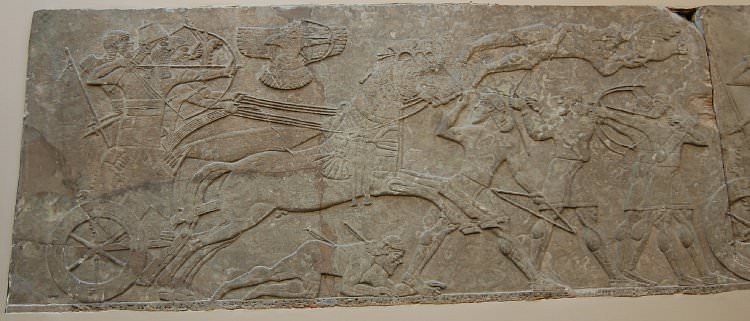
Rise to Power
In the tumult following Hammurabi's death, different powers controlled the region and their gods were considered supreme. The Mitanni and the Hittites both held Ashur and Assyrian areas as a vassal state until they were defeated by the Assyrian king Adad Nirari I (r. 1307-1275 BCE), who united the lands under the first semblance of an empire. Assur is credited by the king as the god who granted him the victory, but no written history of the god existed to glorify. Scholar Jeremy Black comments on this:
Eventually, with the growth of Assyria and the increase in cultural contacts with southern Mesopotamia, there was a tendency to assimilate Assur to certain of the major deities of the Sumerian and Babylonian pantheons. From about 1300 BCE we can trace some attempts to identify him with Sumerian Enlil. This probably represents an effort to cast him as the chief of the gods...Then, under Sargon II of Assyria (reigned 722-705 BCE), Assur tended to be identified with Anshar, the father of Anu (An) in the Babylonian Epic of Creation. The process thus represented Assur as a god of long-standing, present from the creation of the universe. (37-38)
From the time of Adad Nirari I to the time of the Neo-Assyrian Empire of Sargon II, Assur continued to rise in prominence. In the Enuma Elish, Assur (under the name Anshar) replaced Marduk as the hero. Tiglath Pileser I (r. 1115-1076 BCE) regularly invokes Assur as the god of the empire who empowers the army and leads them to victory and even credits Assur with the laws of the empire. Adad Nirari II (r. 912-891 BCE) expanded the empire in every direction with Assur as his personal patron.
Everywhere the Assyrian army traveled, Assur traveled with them, and thus his worship spread across Mesopotamia. Wallis Budge writes:
As the power of Marduk became predominant when Babylon grew into a great city, so the power of Assur waxed great when the Assyrians became a strong and warlike nation. (88)
To the men who marched in the Assyrian forces, as well as to those they conquered, Assur was obviously a powerful god worthy of worship and devotion and, in time, he became so powerful as to eclipse the earlier gods of the region.
Assur, the Supreme God
When Ashurnasirpal II (r. 884-859 BCE) came to power, he moved the capital of the empire from Ashur to the city of Kalhu, but this is no indication of waning power on Assur's part; Ashurnasirpal II had Assur's name as part of his own (his name means 'Assur is Guardian of the Heir'). The reason for the capital's move is unclear, but most likely it was only because Ashur had grown so great and the populace fiercely proud and Ashurnasirpal II wanted to surround himself with humbler and more easily manageable people.
Tiglath Pileser III (r. 745-727 BCE) elevated Assur's name even higher through the stunning victories which marked his reign. Tiglath Pileser III created the first professional army in the history of the world, who, armed with iron weapons, were invincible. Along with the new kind of army, new technology was created such as siege engines which allowed the army to take whole cities with fewer losses.
As the Assyrian armies campaigned throughout the land, Assur was credited with leading them to greater and greater victories. Previously, however, Assur had been linked with the temple of the city of Ashur and had only been worshiped there. As the Assyrians made wider and wider gains in territory, a new way of imagining the god became necessary in order to continue that worship in other locales. Scholar Paul Kriwaczek explains how, in order to maintain worship of Assur, the nature of a god - and how that god should be understood and worshiped - had to change:
One might pray to Assur not only in his own temple in his own city, but anywhere. As the Assyrian empire expanded its borders, Assur was encountered in even the most distant places. From faith in an omnipresent god to belief in a single god is not a long step. Since He was everywhere, people came to understand that, in some sense, local divinities were just different manifestations of the same Assur. (231)
This unity of vision of a supreme deity helped to further unify the regions of the empire. The different gods of the conquered peoples and their various religious practices became absorbed into the worship of Assur, who was recognized as the one true god who had been called different names by different people in the past but who now was clearly known and could be properly worshiped as the universal deity. Regarding this, Kriwaczek writes:
Belief in the transcendence rather than immanence of the divine had important consequences. Nature came to be desacralized, deconsecrated. Since the gods were outside and above nature, humanity – according to Mesopotamian belief created in the likeness of the gods and as servant to the gods – must be outside and above nature too. Rather than an integral part of the natural earth, the human race was now her superior and her ruler. The new attitude was later summed up in Genesis 1:26: 'And God said, Let us make man in our image, after our likeness: and let him have dominion over the fish of the sea, and over the fowl of the air, and over the cattle, and over all the earth, and over every creeping thing that creepeth upon the earth' That is all very well for men, explicitly singled out in that passage. But for women it poses an insurmountable difficulty. While males can delude themselves and each other that they are outside, above, and superior to nature, women cannot so distance themselves, for their physiology makes them clearly and obviously part of the natural world…It is no accident that even today those religions that put most emphasis on God's utter transcendence and the impossibility even to imagine His reality should relegate women to a lower rung of existence, their participation in public religious worship only grudgingly permitted, if at all. (229-230)
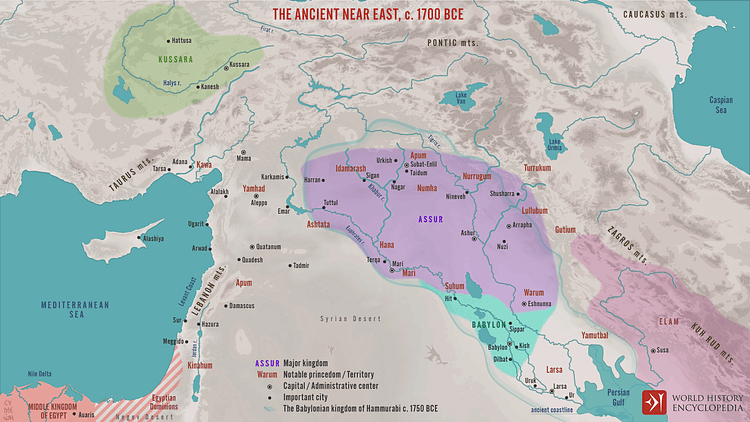
Women in Mesopotamia had enjoyed significant civil rights until the rise of Hammurabi and his god Marduk. Under Hammurabi's reign, female deities began to lose prestige as male gods became increasingly elevated. Under Assyrian rule, with Assur as supreme god, women's rights suffered further. Cultures like the Phoenicians, who had always regarded women with great respect, were forced to follow the customs and beliefs of the conquerors.
The Assyrian culture became increasingly cohesive with the expansion of the empire, the new understanding of the deity, and the assimilation of the people from the conquered regions. Shalmaneser III (r. 859-824 BCE) expanded the empire up through the coast of the Mediterranean and received regular tribute from wealthy Phoenician cities such as Tyre and Sidon.
Assur was now the supreme god not only of the Assyrians but of all those people who were brought under their rule. To the Assyrians, of course, this was an ideal situation, but this opinion was not shared by every nationality they had conquered, and when the opportunity presented itself, they would vent their frustrations dramatically.
The End of Assur
The Neo-Assyrian Empire (912-612 BCE) is the last expression of Assyrian political power in the Near East and is the one most familiar to students of ancient history. The kings of this period are the ones most often mentioned in the Bible and best known by people in the present day. It is also the era that most decisively gives the Assyrian Empire the reputation it has for ruthlessness and cruelty. Kriwaczek comments on this, writing:
Assyria must surely have among the worst press notices of any state in history. Babylon may be a byname for corruption, decadence and sin but the Assyrians and their famous rulers, with terrifying names like Shalmaneser, Tiglath-Pileser, Sennacherib, Esarhaddon and Ashurbanipal, rate in the popular imagination just below Adolf Hitler and Genghis Khan for cruelty, violence, and sheer murderous savagery. (208)
Although there is no denying the Assyrians could be ruthless and were quite clearly not to be trifled with, they were really no more savage or barbaric than any other ancient civilization. In order to form and maintain an empire, they destroyed cities and murdered people, but in this, they were no different from those who preceded and followed them, save in that they were easily more efficient than most.
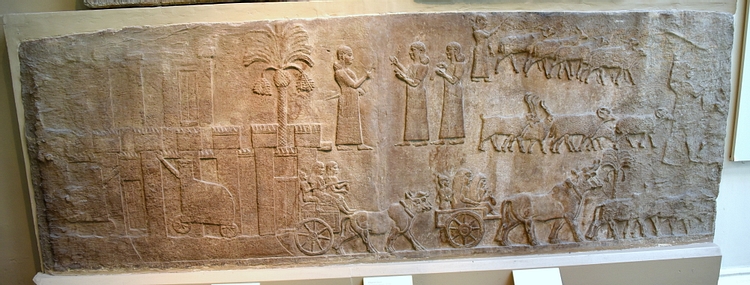
To the conquered people, however, the Assyrians were seen as hated overlords. The last great king of the empire was Ashurbanipal (r. 668-627 BCE) and, after him, the empire began to break apart. There were many reasons for this but, mainly, it had simply grown too large to manage. As the power of the central government became less and less able to cope, more territories broke away from the empire.
In 612 BCE a coalition of Babylonians, Medes, Persians, and others rose against the Assyrian cities and destroyed them. Included in this onslaught was the city of Ashur and the temple of the god as well as other statues of Assur elsewhere. Assur had come to personify the Assyrians, their military victories, and their political power, and so the destruction of this symbol was of special importance to Assyria's enemies.
Worship of Assur continued in Assyrian communities after the fall of the empire but was no longer widespread and no temples, shrines, or statuaries were left standing in the cities and regions which had revolted. In the early Christian era, the understanding of Assur as an omnipotent deity worked well for the early Christian missionaries to the region, who found the Assyrians receptive to their message of a single god and the concept of this god's son coming to earth for the benefit of humanity.
Although Assur's son Nabu never became incarnated or sacrificed himself for others, he was thought to have given human beings the gift of the written word. Nabu continued to be venerated after the fall of the empire, and although Assur declined in stature, he was remembered and is still present (often as Ashur) as a personal and family name in the present day.
